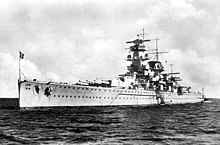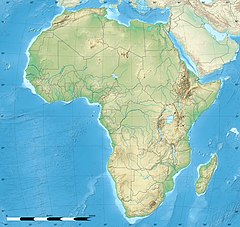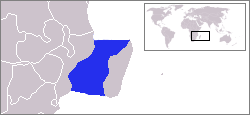
The Mozambique Channel is an arm of the Indian Ocean located between the Southeast African countries of Madagascar and Mozambique. The channel is about 1,700 km long and 419 km across at its narrowest point, and reaches a depth of 3,292 m (10,801 ft) about 230 km off the coast of Mozambique. A warm current, the Mozambique Current, flows in a southward direction in the channel, leading into the Agulhas Current off the east coast of Southern Africa.

The Battle of the River Plate was fought in the South Atlantic on 13 December 1939 as the first naval battle of the Second World War. The Kriegsmarine heavy cruiser Admiral Graf Spee, commanded by Captain Hans Langsdorff, engaged a Royal Navy squadron, commanded by Commodore Henry Harwood, comprising the light cruisers HMS Ajax, HMS Achilles and the heavy cruiser HMS Exeter.
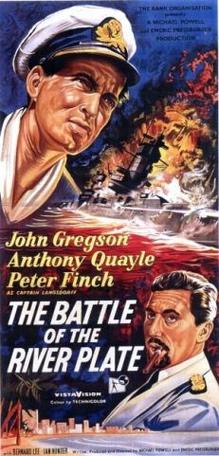
The Battle of the River Plate is a 1956 British war film in Technicolor and VistaVision by the writer-director-producer team of Michael Powell and Emeric Pressburger. The film stars John Gregson, Anthony Quayle, Bernard Lee and Peter Finch. It was distributed worldwide by Rank Film Distributors Ltd.

Hans Wilhelm Langsdorff was a German naval officer, most famous for his command of the German pocket battleship Admiral Graf Spee before and during the Battle of the River Plate off the coast of Uruguay in 1939. After the Panzerschiff was unable to escape a pursuing squadron of Royal Navy ships, Langsdorff scuttled his ship. Three days later he died by suicide in his hotel room in Buenos Aires, Argentina.

Maximilian Johannes Maria Hubert Reichsgraf von Spee was a naval officer of the German Kaiserliche Marine, who commanded the East Asia Squadron during World War I. Spee entered the navy in 1878 and served in a variety of roles and locations, including on a colonial gunboat in German West Africa in the 1880s, the East Africa Squadron in the late 1890s, and as commander of several warships in the main German fleet in the early 1900s. During his time in Germany in the late 1880s and early 1890s, he married his wife, Margareta, and had three children, his sons Heinrich and Otto and his daughter Huberta. By 1912, he had returned to the East Asia Squadron as its commander, and was promoted to the rank of Vizeadmiral the following year.

Admiral Scheer was a Deutschland-class heavy cruiser which served with the Kriegsmarine (Navy) of Nazi Germany during World War II. The vessel was named after Admiral Reinhard Scheer, German commander in the Battle of Jutland. She was laid down at the Reichsmarinewerft shipyard in Wilhelmshaven in June 1931 and completed by November 1934. Originally classified as an armored ship by the Reichsmarine, in February 1940 the Germans reclassified the remaining two ships of this class as heavy cruisers.
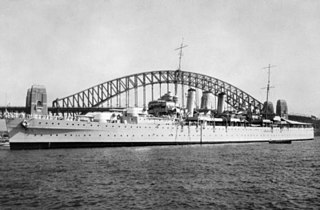
HMS Dorsetshire was a County-class heavy cruiser of the British Royal Navy, named after the English county, now usually known as Dorset. The ship was a member of the Norfolk sub-class, of which Norfolk was the only other unit; the County class comprised a further eleven ships in two other sub-classes. Dorsetshire was built at the Portsmouth Dockyard; her keel was laid in September 1927, she was launched in January 1929, and was completed in September 1930. Dorsetshire was armed with a main battery of eight 8 in (203 mm) guns, and had a top speed of 31.5 knots.
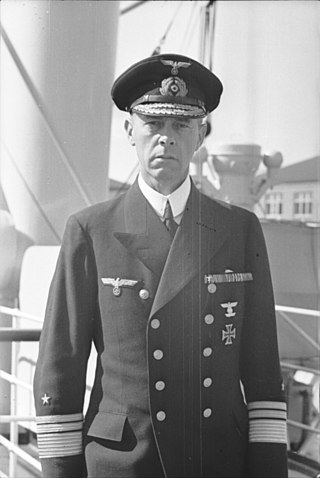
Operation Rheinübung was the last sortie into the Atlantic by the new German battleship Bismarck and heavy cruiser Prinz Eugen on 18–27 May 1941, during World War II. This operation aimed to block Allied shipping to the United Kingdom as the previously successful Operation Berlin had done. After Bismarck had sunk HMS Hood during battle of the Denmark Strait, it culminated with the sinking of Bismarck, while Prinz Eugen escaped to port in occupied France. From that point on, Germans would rely only on U-boats to wage the Battle of the Atlantic.

HMS Exeter was the second and last York-class heavy cruiser built for the Royal Navy during the late 1920s. Aside from a temporary deployment with the Mediterranean Fleet during the Abyssinia Crisis of 1935–1936, she spent the bulk of the 1930s assigned to the Atlantic Fleet or the North America and West Indies Station. When World War II began in September 1939, the cruiser was assigned to patrol South American waters against German commerce raiders. Exeter was one of three British cruisers that fought the German heavy cruiser Admiral Graf Spee, later that year in the Battle of the River Plate. She was severely damaged during the battle, and she was under repair for over a year.
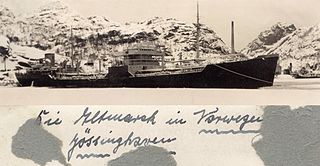
Altmark was a German oil tanker and supply vessel, one of five of a class built between 1937 and 1939. She is best known for her support of the German commerce raider, the "pocket battleship" Admiral Graf Spee and her subsequent involvement in the "Altmark Incident". In 1940 she was renamed Uckermark and used as supply tanker for the battleships Scharnhorst and Gneisenau during Operation Berlin before sailing to Japan on September 1942 as a blockade breaker.

The Deutschland class was a series of three Panzerschiffe, a form of heavily armed cruiser, built by the Reichsmarine officially in accordance with restrictions imposed by the Treaty of Versailles. The ships of the class, Deutschland, Admiral Scheer, and Admiral Graf Spee, were all stated to displace 10,000 long tons (10,160 t) in accordance with the Treaty, though they actually displaced 10,600 to 12,340 long tons at standard displacement. The design for the ships incorporated several radical innovations, including the first major use of welding in a warship and all-diesel propulsion. Due to their heavy armament of six 28 cm (11 in) guns and lighter weight, the British began referring to the vessels as "pocket battleships". The Deutschland-class ships were initially classified as Panzerschiffe, but the Kriegsmarine reclassified them as heavy cruisers in February 1940.
Convoy HX 84 was the 84th of the numbered series of Allied North Atlantic HX convoys of merchant ships from Halifax, Nova Scotia, and Bermuda to Liverpool, England, during the Battle of the Atlantic. Thirty-eight ships escorted by the armed merchant cruiser HMS Jervis Bay departed from Halifax on 28 October 1940, eastbound to Liverpool.
Jürgen Wattenberg was a German naval officer and U-boat commander during the Second World War. In a successful career spanning just under a year, he sank 14 ships, a total of 82,027 gross register tons (GRT).

Gneisenau was a German capital ship, alternatively described as a battleship and battlecruiser, in Nazi Germany's Kriegsmarine. She was the second vessel of her class, which included her sister ship, Scharnhorst. The ship was built at the Deutsche Werke dockyard in Kiel; she was laid down on 6 May 1935 and launched on 8 December 1936. Her outfitting was completed in May 1938: she was armed with a main battery of nine 28 cm (11 in) C/34 guns in three triple turrets. At one point after construction had started, a plan had been approved to replace these weapons with six 38 cm (15 in) SK C/34 guns in twin turrets, but when it was realized that this would involve a lot of redesign, that plan was abandoned, and construction continued with the originally planned lower-calibre guns. The upgrade had been intended to be completed in the winter of 1940–41, but instead, due to the outbreak of World War II, that work was stopped.

Admiral Graf Spee was a Deutschland-class "Panzerschiff", nicknamed a "pocket battleship" by the British, which served with the Kriegsmarine of Nazi Germany during World War II. The vessel was named after World War I Admiral Maximilian von Spee, commander of the East Asia Squadron who fought the battles of Coronel and the Falkland Islands, where he was killed in action. She was laid down at the Reichsmarinewerft shipyard in Wilhelmshaven in October 1932 and completed by January 1936. The ship was nominally under the 10,000 long tons (10,160 t) limitation on warship size imposed by the Treaty of Versailles, though with a full load displacement of 16,020 long tons (16,280 t), she significantly exceeded it. Armed with six 28 cm (11 in) guns in two triple gun turrets, Admiral Graf Spee and her sisters were designed to outgun any cruiser fast enough to catch them. Their top speed of 28 knots left only a few capital ships in the Anglo-French navies fast enough and powerful enough to sink them.
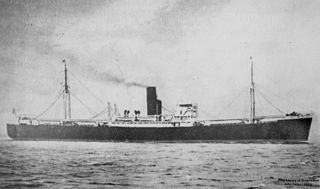
SS Clement was a British turbine steamship operated by the Alfred Booth and Company from 1934 to 1939 until she was intercepted and sunk by the German pocket battleship Admiral Graf Spee off the east coast of Brazil becoming the first victim of Graf Spee's commerce raiding sortie
SS Doric Star was a British cargo liner operated by the Blue Star Line from 1922 to 1939, when she was intercepted and sunk by the German pocket battleship Admiral Graf Spee off the coast of South West Africa, becoming the seventh victim of the commerce raiding sortie of Graf Spee.
Patrick G.G. (Paddy) Dove (1896–1957) was a British merchant navy officer who served as commanding officer of the MV Africa Shell when she was intercepted and sunk by the German pocket battleship Admiral Graf Spee in the Mozambique Channel, off the coast of Portuguese East Africa, becoming the sixth victim of Graf Spee's commerce raiding sortie.
SS Tairoa was a British cargo liner and refrigerated freight ship, operated by the Shaw, Savill & Albion Line from 1920 to 1939, until she was intercepted and sunk by the German pocket battleship, Admiral Graf Spee, off South West Africa, becoming the penultimate victim of Graf Spee's commerce raiding sortie.
SS Mopan was a British steam cargo liner operated by the Fyffes Line from 1929 to 1940 until she was intercepted in mid-Atlantic and sunk by the German pocket battleship Admiral Scheer, becoming the first victim of Admiral Scheer's commerce raiding sortie.
